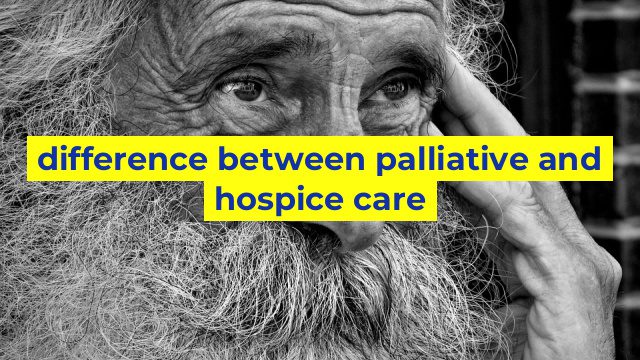Understanding the Difference between Palliative and Hospice Care
When it comes to end-of-life care, there are two main options: palliative care and hospice care. While both aim to provide comfort to patients, there are significant differences between the two. Understanding these differences can help patients and their loved ones make informed decisions about the best possible care.
Palliative Care
Palliative care is specialized medical care for individuals with serious or chronic illnesses. It is often provided alongside curative treatment, and its goal is to improve the quality of life for patients and their families by managing symptoms and addressing emotional and spiritual needs.
Palliative care can be offered at any stage of an illness and can be provided in various settings, including hospitals, nursing homes, and patients’ homes. It is a comprehensive approach that involves a team of healthcare providers, including physicians, nurses, social workers, and chaplains.
The main objective of palliative care is to manage pain, reduce symptoms, and improve the overall quality of life for the patient. This includes the management of physical symptoms such as pain, nausea, and fatigue, as well as emotional and psychological symptoms such as anxiety, depression, and fear.
Hospice Care
Hospice care, on the other hand, is a form of palliative care specifically designed for patients who are approaching the end of their lives. Hospice care is meant for individuals who have a life expectancy of six months or less.
Hospice care focuses on providing comfort and support to the patient and their loved ones in the final stages of life. It is generally administered in the patient’s home, although hospice care can also be provided in nursing homes, hospital-based hospice units, or dedicated hospice facilities.
The care provided under hospice is palliative in nature and incorporates pain and symptom management, emotional and spiritual support, and assistance with daily activities. This type of care is typically provided by a team of healthcare professionals, including hospice nurses, social workers, and chaplains.
The Main Difference between Palliative and Hospice Care
The main difference between palliative and hospice care is that while both aim to provide comfort, palliative care can be given throughout the course of a serious illness, regardless of life expectancy. In contrast, hospice care specifically targets patients with a limited life expectancy and is focused on end-of-life care.
Another critical difference is that while palliative care is often provided in conjunction with treatments aimed at curing or managing an illness, hospice care is focused solely on providing comfort and support to patients, rather than treating the underlying disease.
In conclusion, palliative and hospice care are similar in that they both aim to improve patients’ quality of life by providing comfort measures, reducing symptoms, and addressing emotional and spiritual needs. However, the primary difference lies in the stage of the illness targeted and the objectives of the care. Understanding these differences can help families make more informed decisions about the end-of-life care for their loved ones.
Table difference between palliative and hospice care
| Palliative Care | Hospice Care |
|---|---|
| Palliative care focuses on relieving pain, symptoms, and stress for those with chronic, serious, or life-limiting conditions. | Hospice care is a type of palliative care but is specifically designed for people who are in the last stages of a terminal illness and focuses on managing symptoms and comfort care. |
| Palliative care can be provided at any stage of an illness and can be provided in hospitals, clinics, or at home. | Hospice care is provided to patients with a prognosis of six months or less to live and is typically provided in the home or in a dedicated hospice facility. |
| Palliative care may include treatments such as chemotherapy, radiation, or surgery alongside symptom management and emotional support. | Hospice care focuses on pain and symptom management, emotional and spiritual support, and enhancing quality of life in the final months of life. |
| Palliative care can be a part of a patient’s care plan alongside curative treatments and can be provided simultaneously. | Hospice care is a comprehensive approach to end-of-life care and focuses on comfort measures. |
| Palliative care can be provided by a team of healthcare professionals, including doctors, nurses, social workers, and chaplains. | Hospice care is provided by a team of healthcare professionals, including doctors, nurses, social workers, chaplains, and volunteers. |

